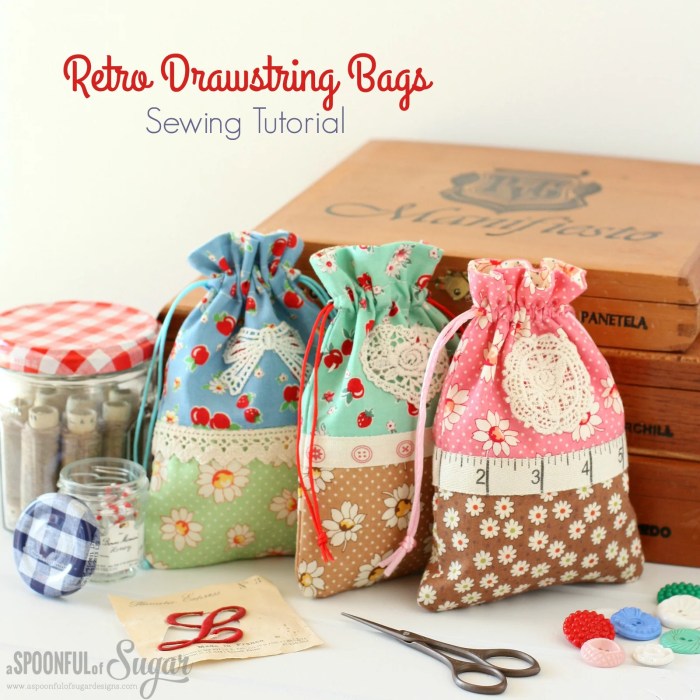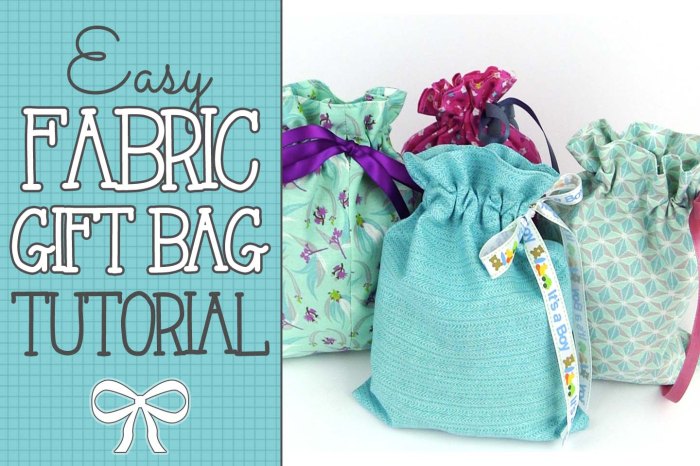DIY drawstring pouches offer a delightful blend of practicality and creativity, allowing you to craft personalized storage solutions for your everyday needs. From simple designs to intricate embellishments, the possibilities are endless.
These versatile pouches can be used for everything from carrying your essentials to organizing your belongings, making them a must-have for anyone who appreciates a touch of handmade charm.
Troubleshooting and Tips

It’s completely normal to encounter some hiccups while crafting your drawstring pouch. This section offers solutions to common sewing errors and valuable tips to ensure your creation is durable and long-lasting.
Troubleshooting Common Sewing Errors
Sewing errors are inevitable, especially for beginners. Here are some common mistakes and their solutions:
- Uneven Stitching: This can be caused by inconsistent pressure on the foot pedal or improper thread tension. Adjust the foot pedal pressure for smoother stitching, and check the thread tension settings for optimal results.
- Fabric Puckering: This occurs when the fabric is pulled too tightly during stitching. Use a walking foot or a special needle for slippery fabrics to prevent puckering.
- Skipped Stitches: This could be due to a dull needle, improper thread tension, or a clogged bobbin case. Replace the needle with a sharp one, adjust the thread tension, and clean the bobbin case.
- Fabric Fraying: To prevent fabric fraying, use a serger or zigzag stitch along the raw edges of the fabric.
Maintaining and Cleaning Your DIY Drawstring Pouch
- Gentle Cleaning: For most fabric types, hand-washing with mild detergent is recommended. Avoid harsh chemicals or machine washing, as this can damage the fabric and stitching.
- Air Drying: After washing, gently squeeze out excess water and lay the pouch flat on a clean towel to air dry. Avoid direct sunlight or heat, as this can cause fading or shrinkage.
- Storing Properly: Store your pouch in a cool, dry place, away from direct sunlight and moisture.
Improving Your Drawstring Pouch Design
- Adding Pockets: Consider adding interior pockets to the pouch for better organization. You can use different fabric types and colors to create a unique look.
- Reinforcing Stress Points: For added durability, reinforce the corners and drawstring openings with additional stitching or fabric patches.
- Choosing the Right Fabric: Select a fabric that is durable, easy to sew, and suitable for the intended use of the pouch.
Creative Variations: Diy Drawstring Pouch

The possibilities for creating unique and innovative drawstring pouches are practically limitless. Beyond the basic design, you can explore different materials, embellishments, and techniques to make your pouches truly stand out. This section will delve into some creative variations to inspire your next project.
Upcycled Materials
Upcycling is a fantastic way to give new life to old materials and create sustainable, eco-friendly pouches. Consider using discarded fabrics like old t-shirts, jeans, curtains, or even repurposed packaging materials like burlap sacks or canvas drop cloths.
“Upcycling involves transforming waste materials into something of higher quality or value.”
For example, a vintage t-shirt with a cool graphic could be repurposed into a stylish pouch. The fabric’s unique texture and pattern would add character and personality to the design. Similarly, old jeans can be cut and sewn into durable and practical pouches, perfect for carrying small tools or electronics.
Unconventional Fabrics, Diy drawstring pouch
Don’t limit yourself to traditional fabrics! Experiment with unconventional materials like leather, cork, felt, or even waterproof fabrics like nylon or canvas. These materials offer different textures, durability, and aesthetics, allowing you to create pouches with unique looks and functionalities.
“Unconventional fabrics can add a touch of whimsy and sophistication to your drawstring pouch designs.”
For instance, a leather pouch with a braided drawstring would exude a rustic charm, while a cork pouch would offer a natural and sustainable option. Felt, with its soft and pliable texture, can be used to create pouches with a cozy and comfortable feel. Waterproof fabrics are ideal for pouches designed for outdoor activities or carrying wet items.
Drawstring Pouch Styles
A drawstring pouch is a versatile design that can be adapted to create various styles and functionalities.
| Style | Description | Example Uses |
|---|---|---|
| Cinched Bag | A simple and compact pouch with a cinched top for closure. | Carrying small essentials, storing jewelry, or holding makeup. |
| Backpack | A larger pouch with shoulder straps for carrying heavier items. | School supplies, hiking gear, or everyday essentials. |
| Tote Bag | A wider and more spacious pouch with handles for easy carrying. | Grocery shopping, carrying books, or transporting larger items. |
Creating your own DIY drawstring pouch is a rewarding experience that allows you to express your unique style while crafting a functional accessory. With the right materials and techniques, you can easily sew a pouch that’s both beautiful and practical. So, gather your supplies and embark on this exciting crafting journey!
DIY drawstring pouches are a fun and practical project for anyone looking to personalize their belongings. While working on your pouch, you might want to take a break and research potential side effects of medications like Humira, available here , to ensure you’re taking them safely. Once you’re back to your pouch, you can add a touch of flair with colorful fabrics or embroidery.
